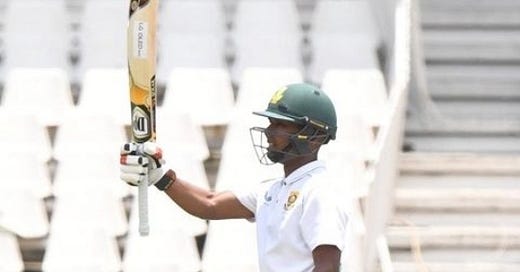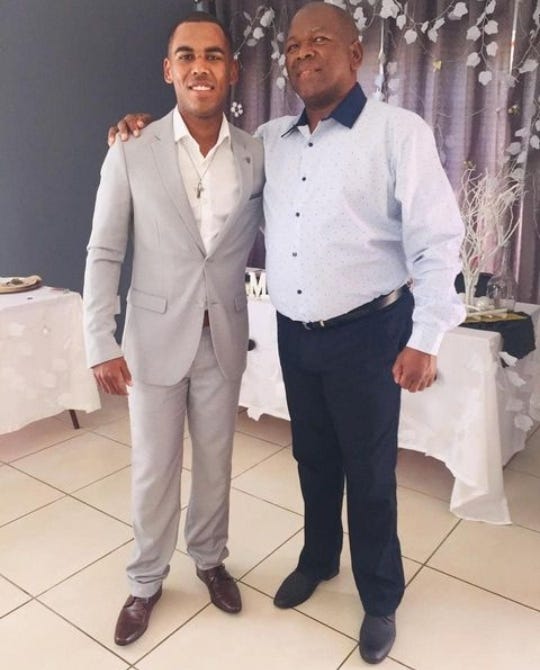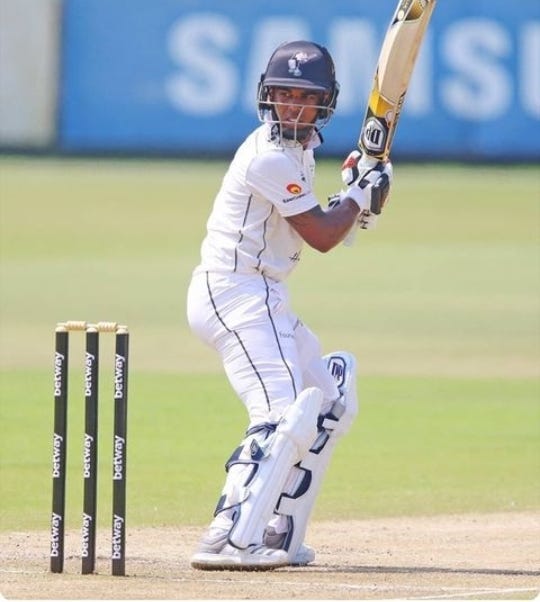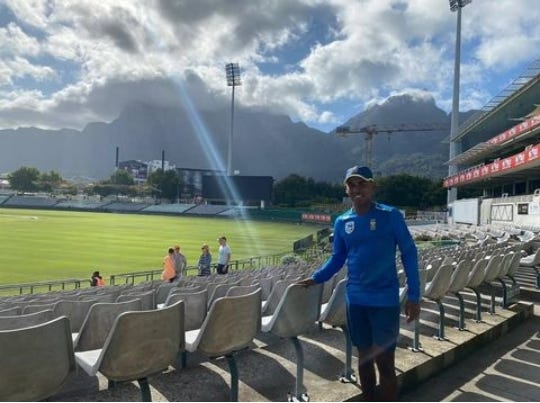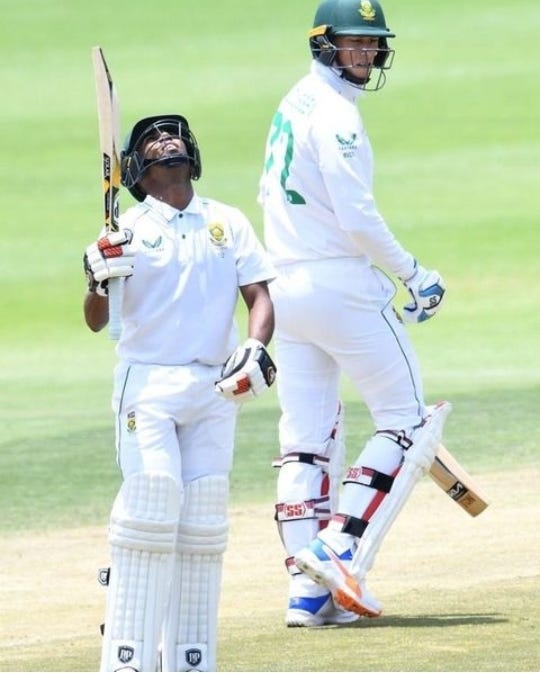If you missed the previous article, it’s Coffee Beans and Cricket Balls:
Keegan’s journey to the top has been a long walk, both figuratively and literally. For most of the journey, Keegan has had his father, Dirk ‘Dirkie’ by his side. He is his own man now.
If you are not a subscriber of Stumped!, join more than a thousand other professional athletes & ex-pros, coaches, commentators & analysts and casual sports fans that receive the newsletter in their inbox each week — it’s free:
Keegan Petersen spent large parts of his childhood on the grassbanks and sidelines of Parys cricket fields. That is where his father, Dirk ‘Dirkie’ Petersen, played home matches throughout his club cricket career with Paarl Cricket Club.
During Dirkie’s playing years, there was no fortune to be made in sports. There was the odd international excursion - in 1992, Dirkie was part of the SA Schools rugby team that competed at the Student World Cup in Italy. Besides that, there was nothing else. For Dirkie’s generation, all sports were amateur sports. The age of professionalism was light-years away.
“I never got paid to play cricket or rugby,” says Dirk Petersen, a lifelong school teacher. “We used to do it for the pleasure and fun of it.”
Sports were a community event. They were the glue that bound the community together. When Dirkie took Keegan to cricket and rugby matches (at Greenpoint Track), he was doing what every parent did. Matchdays were always festive family outings. Families congregated on the grassbanks with picnic baskets.
It’s little surprise that Keegan’s first memories of cricket are of his father throwing balls for him on the sidelines of Parys cricket fields. That is what every parent did, they played with their sons and daughters as they waited for their turn to bat or after dismissal. Every parent thought their child had the makings of a cricketer and was very encouraging.
Using a junior bat bought at Newlands Stadium, Keegan tried to slog sweep about 60% of the balls he faced. He was imitating his father. Dirkie played the slog sweep better than anyone Keegan had ever seen. Keegan wanted to execute it as well as his father did.
Dirkie feels at home whenever he visits Parys cricket fields. For Keegan, that feeling comes over him when he visits Boland park. Keegan has always wanted to play cricket at Boland Park. Besides the Parys cricket fields, Boland Park was the other place where Keegan received the bulk of the theory side of his cricket education.
“I always took Keegan to watch matches at Boland Park from the time he was very young. Little did I know that he would play there someday,” says Dirkie.
In 2011, father and son were in the stands at Boland Park, sharing opinions on the competing teams, as always. They had that Earl and young Tiger Woods vibe about them. Father and son enjoying a sport they both loved, father optimistic that his son would have a better career in the sport than he had. Like Earl, Dirkie had probably told everyone that Keegan would be the best in the world when Keegan was still a toddler.
“As a five year-old, Keegan could hit the ball well,” says Dirkie. “Even at that stage, his hand and eye coordination was very good. I then realised that this boy had something good going.”
Earl Woods used to jingle keys and coins during Tiger’s backswing to increase his concentration. He also gave 13-year-old Tiger an earful after the boy had behaved badly at a tournament. He also read Tiger the riot act after the boy had not given his all at a junior tournament.
Dirkie was as hard-driving as Earl Woods. After matches, he would highlight areas that he felt Keegan needed to improve on. He would pick up on the loose shots and point to the flaws associated with them. The moments of feedback did not always end well, some ended up in fights as Keegan defended his choices.
Like Earl’s key and coins, the scrutiny was meant to toughen Keegan up. Prepare him for greater and more intense scrutiny that waited for him ahead if he turned professional.
Dirkie and Keegan’s relationship was also different from Earl and Tiger’s relationship in a lot of other ways. Earl and Tiger did everything together for most of Tiger’s life. They spent hours in the garage hitting golf balls in the garage into a net or on the golf course practising. Afterwards, like two old friends, Earl and Tiger would retire at the bar where they nursed drinks and traded stories. Earl would have a rum and Coke, while Tiger sipped on a Coke with cherries.
Keegan also had interests that did not intersect with Dirkie’s. He cultivated his own circle of friends whom he spent significant portions of his time with. Tiger spent his time with Earl and Earl’s friends, old former servicemen.
Keegan's first bat was not really a bat. It was a bat, but not a batter's bat. Keegan was in line to play his first hardball game, an under-11 game, and he had no kit. No pads, no gloves, no bat, nothing. For weeks in the run-up to the game, he had pestered Dirkie for a new bat.
“Two nights before the game, my dad bought me a little bat that the coaches hit catches with,” says Keegan.
Dirkie had bought a catching practice bat.
The fungo bat. That is the catching practice bat's closest relative. Baseball coaches use the fungo bat, which is lighter and longer than a regular baseball bat, for practice and to facilitate drills. The cricket catching practice bat does not have as snazzy a name as a fungo bat. The cricket universe calls it by the job it does: catching practice bat.
The catching practice bat was cheaper than a regular cricket bat. It was a good deal, Dirkie had thought. He would get Keegan a proper bat in a year or two. Surely Keegan wouldn't mind.
Dirkie was wrong. Keegan did mind very much.
If he showed up with that bat his friends would destroy him. They would tear him to pieces. He would sooner show up with an old bat than what his father had bought him. When it came to important decisions, the opinion of his friends mattered. The kind of bat he had would determine whether he was viewed as cool or become a laughing stock. A catching practice bat was not cool and would not make him look cool.
“I was like, ‘No dad, I'm not going to use that. They're going to make fun of me if I show up with that,’” says Keegan.
It's not as if Keegan and his friends came from wealth. When they played street cricket, they used everything from planks to old discarded bats, if they found one - which was not often.
They played street cricket, not backyard cricket. Their backyards were not expansive enough to accommodate all the kids who took part in the makeshift One Day Internationals. The games were regularly interrupted by both foot and vehicular traffic. Hitting a ball into someone's yard brought a game to a stop. The boys scattered in all directions before a lady whose yard their ball had invaded was out of the door to give them an earful.
“I was fortunate to grow up with lots of kids of my age around me,” says Keegan. “We never took a break from cricket. We played cricket at school and after school, you just popped into the house, ate and quickly popped outside to play cricket or touch rugby or whatever. But, it was cricket most of the time.”
There is a difference with today’s generation of teens from the area. Through their teens, Keegan and his friends wanted to grow up to be athletes like Chester Williams, Tinus Linee and a few others who made careers out of sports. Modern youths want different numbers. Instead of shirt numbers, they want gang numbers.
The area where Keegan grew up is a ghetto, as Keegan calls it. But not an extreme ghetto. Dirkie was a social sciences teacher. Dirkie had a lengthy spell working for the Correctional Services Department. When he left that job, he went back to teaching.
Keegan’s parents had stable employment. They were okay. They were among the fortunate ones.
Dirkie folded. The next day he returned the catching practice bat and came back with a Grey Nicolls bat. Keegan used that Grey Nicolls bat for the better part of three years. That is the bat he played with when he played his first game at Boland Park, an under-13 match for Boland.
“It was a dream come true,” Keegan reminisces.
Dirkie made provincial A-teams early on in his career. He was in the Western Province Under-16 A-side. Dirkie is not the tallest man around. He is small in stature. Keegan describes him as a nudger of the ball. Dirkie accumulated runs by working the gaps and running hard between the wickets.
Like his father, Keegan is also small in stature. But, unlike his father, Keegan never made representative A-teams. He was always stuck in the B-sides, despite his obvious talent. The problem was probably his height.
“Keegan was very small in stature, so he could not hit the ball very far. He hit the odd four here and there,” says Dirkie. “But, he had the ability as a young boy to block the ball the whole day. He used to open the batting and could bat right through the innings of 50 overs.”
Maybe coaches were on the lookout for bigger and stronger players to open the batting or bat in the top order. They seemed blind to his exploits for New Orleans High School, not even the 100 he scored against a strong Stellenbosch High bowling attack made anyone think of giving him a run in the A-side.
Keegan’s big break came in 2009. Allan Alexander was putting together an invitational team for a two-match series against a touring Surrey side. Alexander asked Dirkie if he could add Keegan to the team. Keegan did not hesitate when his father asked him. He was more than happy to play.
Keegan was the player of the series. He scooped both Man of The Match awards on offer. That is when selectors sat up and took notice. After the series, Keegan made the Boland Under-17A team.
Keegan made the Boland senior team in an equally fortuitous manner.
Stumped! is a reader-supported newsletter. Those who opt to leave tips (buy coffees) or become patrons are taking an active role in the work that I do by providing vital assistance to bolster my independent coverage of cricket. Feel free to forward this post to family and friends interested in cricket and/or cricketers.
Keegan’s mother had gone out with the car. She had some stuff to do that required that she had a car. That meant that Keegan and Dirkie had to walk to Boland Park for the Boland vs Griquas match. Unlike earlier in the week, they were not going to watch from the stands. Well, one of them was going to be in the stands and it was not going to be Keegan.
It was 2011. Keegan was 18 years old and a veteran of one Coke Week tournament. He would play another one the following year.
Earlier in the week, Dirkie and Keegan had been sitting in the stands at Boland Park, sharing opinions on the competing teams, as always. Boland was playing against the Griquas. This time it was not just father and son, Noor Rhode and Barney Mohamed had joined them. Rhode was the convenor of selectors for Boland and Mohamed was the Boland Coach.
“Mr Rhode asked me, ‘Do you think you can handle batting against these guys?’” It was a casual conversation. Rhode went back a long way with Dirkie, they had played together in their younger years. “I said, ‘I don't know, I hope to think so.’ He said, ‘Strap up, you are playing on Sunday.’”
The conversation moved on to the players on the field and other cricket-related matters. Keegan had thought nothing more of it afterwards. He had assumed that they were just shooting the breeze. Keegan only realised that it had been a serious conversation that evening when Mohamed called the Petersen's home. Mohamed was calling Dirkie to make arrangements for Keegan’s debut the following Sunday.
Dirkie and Keegan left home early. Boland Park is about five kilometres away from New Orleans. Father and son took turns carrying Keegan’s kit, though Dirkie did most of the carrying. It seemed as if, in that instant, Dirkie’s body had regained some of the strength he possessed during his active years.
Dirkie’s body took a hammering on the rugby field. He felt the effects after he stopped playing. His neck gives problems now and then.
“He always says that if he had known earlier, he wouldn't have played rugby. He says he would make a different choice now because it's just something that comes back to you later on in life,” says Keegan.
But, that Sunday, the aches and pains were gone as he helped his son lug the bag.
“It was a big bag,” says Dirkie.
Father and son arrived at the stadium 45 minutes before the game. The plan had been to reach the stadium ahead of time so that Keegan could have enough time to rest and compose himself.
“It was a long walk. I was both anxious and excited,” says Keegan.
Despite working towards it for years, Keegan was still unprepared when the moment arrived. It happened so suddenly. One moment, Keegan was watching a match in the stands, and the next moment, he was preparing his gear to bat.
Normally, Dirkie trusted Keegan to apply the training he had received to handle game situations. But not on that Sunday morning.
“I think my dad was nervous as I was, he kept telling me about how to handle certain game situations,” says Keegan.
The excitement and anxiety soon vanished. When it was game time, Keegan wore his game face, mustering as expressionless a look as he could. He scored 44 runs on his debut.
On the 28th and 29th of November 2013, one of New Orleans’ finest sons played one of the finest knocks ever witnessed at Boland Park.
When Keegan is ready to face delivery, he taps his bat to the ground very slowly. At around a quarter of his normal speed. In that innings, 20-year-old Keegan spent 471 minutes at the crease and performed his slow bat tap 379 times. He hit 26 fours and three sixes on his way to an unbeaten 225 runs. It was a coming-of-age innings. The following season he moved up to the Cape Cobras.
“That’s why I love Boland Park,” says Dirkie who watched the match. “That is where Keegan scored his highest score.”
Keegan would have loved to debut for the Proteas at Boland Park. He doesn’t play there a lot anymore because as his career blossomed, Keegan had to move away. In his 3 years with the Cobras, Keegan only started in 7 games. With the Knights, his career was going along well, but Keegan felt the need to join a bigger franchise. That’s how he ended up in Durban with the Dolphins.
Now he only plays at Boland Park when the Dolphins take on Boland.
Keegan’s beloved ground has yet to host a Proteas men’s Test match. The only time a Test match was played there was in 2002 when the Momentum Proteas played a Test against India Women.
Keegan made his debut in the West Indies. That day, Dirkie did all he could to ensure he watched the Test live on TV.
“I was in tears the whole day,” says Dirkie. He could hardly teach that day.
They were tears of joy. His heart was swelling with pride. He knew how hard Keegan had fought to get to this point. This was the reward for all the moments Keegan had asked, ‘Daddy let’s go to the nets. Let’s go to practice again so that I can work harder on what the coaches said I must work on.’
As if Dirkie had not cried enough on Keegan’s Proteas debut, Keegan made him cry again less than a month later. It was a brace. A rarity too. Keegan had never made his father cry that often.
When he visited home after the tour to the West Indies, Keegan had a gift for his father. He gave Dirkie his Proteas debut shirt. It was framed. This was his way of sharing the special moment with Dirkie.
“I wanted him to know that even if he had not been there physically, he was still part of my debut,” says Keegan. What makes the moment even better is the fact that Keegan put together the frame, with the help of one of his closest friends.
“It was a huge honour to receive that shirt. My late wife and I cried as he presented it to us,” says Dirkie.
Keegan would have loved it if his father had been able to be in the stands when he scored his first half-century. Dirkie watched the match from his home in New Orleans. But, Keegan also had someone important to witness the innings. His wife and son, whom he saluted with his bat, were in the stands. His son is too young to know or understand what was going on, but Keegan is still proud that he was there.
Dirkie was in the stands when the Proteas played Bangladesh. He is no longer critical of Keegan. That is now Keegan’s job. Keegan is hard on himself. He is proud of his three half-centuries for the Proteas, but he also sees them as missed opportunities.
“I had three chances to score 100 in that series. Each time I passed 50 was chance,” says Keegan. You can almost hear Dirkie’s voice cautioning young Keegan against complacency after reaching a milestone. Dirkie often told him, ‘when you get to a 100, try not to get out. If you get out, the next player might get a duck. Suddenly the team is against the ropes. That’s how the game works. Don’t throw away your wicket.’
His father has taken a step back when it comes to his batting. But, Keegan still reaches out to him for guidance.
“If I have a problem with some aspect of my batting I consult my dad. No one knows my batting like he does. He probably knows my batting better than me,” says Keegan. “He can't really throw anymore is because of all the 1000s of balls he's thrown to me over the years. But, he'll find a way and we'll work on it.”
Whenever people talk about his impact on Keegan’s career, Dirkie is quick to remind them that Keegan’s success is all because of Keegan. From when Keegan was a child, Dirkie has been wary of people attributing Keegan’s successes to him. That is why he was always unwilling to drive Keegan to trials. He did not want people to see Keegan as Dirkie’s boy but as a talented and able youngster who can earn a place on his own.
Dirkie played a part, alongside his wife, in raising a hardworking individual. But, it was Keegan who always had the strength to rise whenever he fell, he was the one that never lost heart when he was overlooked for the representative A teams. Dirkie threw 1000s of balls to Keegan, but only because Keegan pushed him to do so.
Just as he did almost immediately after returning from the Caribbean, Keegan visits home as often as he can. Some of his closest friends are still in New Orleans. His family and community love him as much as he loves them. When Keegan is playing, the streets of Chicago, the New Orleans suburb he grew up in, are deserted. Everyone and their parents and grandparents are glued to TV screens.
The streets fill up again when he is dismissed. Suddenly no one is interested in the game anymore. Kids grab planks and old bats and play their own version of the match. Keegan is the first athlete from the community to represent South Africa in about 10 years.
Keegan is a hometown hero.
Youngsters from Chicago and the greater New Orleans see themselves in Keegan. Yes, he had Dirkie guiding him, throwing thousands of balls to him, day after day. But as Dirkie said, it was Keegan doing the hard work.
Keegan is someone they relate with. He did not benefit from getting a scholarship to one of the prestigious schools that give most youngsters from places like New Orleans a boost. He is a New Orleans High School boy.
Keegan did not blaze the trail by playing for the A-sides in representative sides from Under-11. Keegan is not just one of their own that made it, he is one of their own that worked his way up and climbed over. He worked his way from the fringes to prominence.
Whenever young boys and girls run up to him to shake hands, chat and for autographs each time he visits, this is the Keegan they rush to. One of their own who lived what they live through. This is also the Keegan whom adults from Chicago visit to the Petersens’ home to congratulate whenever he has visited. Keegan’s success is the community’s success.
Thank you for reading. I am entirely freelance and some very nice people help me to continue producing more content by donating a little here and there. Some do so by supporting my work on Patreon.
Others prefer to leave tips:
Others also support sharing posts that they enjoy. You can do all three.


